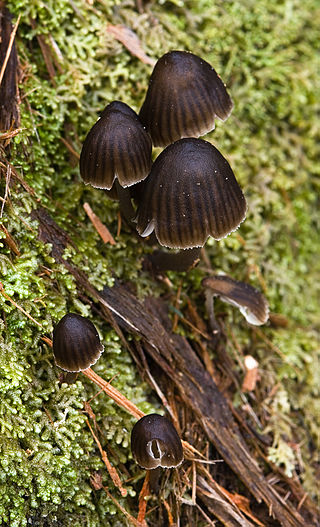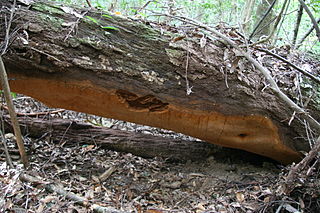
Iodine is a chemical element with the symbol I and atomic number 53. The heaviest of the stable halogens, it exists at standard conditions as a semi-lustrous, non-metallic solid that melts to form a deep violet liquid at 114 °C (237 °F), and boils to a violet gas at 184 °C (363 °F). The element was discovered by the French chemist Bernard Courtois in 1811 and was named two years later by Joseph Louis Gay-Lussac, after the Ancient Greek Ιώδης 'violet-coloured'.

Potassium hydroxide is an inorganic compound with the formula KOH, and is commonly called caustic potash.

Tincture of iodine, iodine tincture, or weak iodine solution is an antiseptic. It is usually 2 to 3% elemental iodine, along with potassium iodide or sodium iodide, dissolved in a mixture of ethanol and water. Tincture solutions are characterized by the presence of alcohol. It was used from 1908 in pre-operative skin preparation by Italian surgeon Antonio Grossich.

Lugol's iodine, also known as aqueous iodine and strong iodine solution, is a solution of potassium iodide with iodine in water. It is a medication and disinfectant used for a number of purposes. Taken by mouth it is used to treat thyrotoxicosis until surgery can be carried out, protect the thyroid gland from radioactive iodine, and to treat iodine deficiency. When applied to the cervix it is used to help in screening for cervical cancer. As a disinfectant it may be applied to small wounds such as a needle stick injury. A small amount may also be used for emergency disinfection of drinking water.

Potassium iodate (KIO3) is an ionic chemical compound consisting of K+ ions and IO3− ions in a 1:1 ratio.

Gymnopilus luteofolius, known as the yellow-gilled gymnopilus, is a large and widely distributed mushroom that grows in dense clusters on dead hardwoods and conifers. It grows in late July to November in the east and in the winter on the west coast of North America. It has a rusty orange spore print and a bitter taste.
In mycology a tissue or feature is said to be amyloid if it has a positive amyloid reaction when subjected to a crude chemical test using iodine as an ingredient of either Melzer's reagent or Lugol's solution, producing a blue to blue-black staining. The term "amyloid" is derived from the Latin amyloideus ("starch-like"). It refers to the fact that starch gives a similar reaction, also called an amyloid reaction. The test can be on microscopic features, such as spore walls or hyphal walls, or the apical apparatus or entire ascus wall of an ascus, or be a macroscopic reaction on tissue where a drop of the reagent is applied. Negative reactions, called inamyloid or nonamyloid, are for structures that remain pale yellow-brown or clear. A reaction producing a deep reddish to reddish-brown staining is either termed a dextrinoid reaction or a hemiamyloid reaction.
Chemical tests in mushroom identification are methods that aid in determining the variety of some fungi. The most useful tests are Melzer's reagent and potassium hydroxide.

In chemistry, the haloform reaction is a chemical reaction in which a haloform is produced by the exhaustive halogenation of an acetyl group, in the presence of a base. The reaction can be used to transform acetyl groups into carboxyl groups or to produce chloroform, bromoform, or iodoform. Note that fluoroform can't be prepared in this way.

Rhodocollybia is a genus of Basidiomycete mushroom. Species in this genus, formerly classified as a subgenus in Collybia, have fairly large caps, and have a pinkish-tinted spore print. Microscopically, they are characterized by having spores and basidia that are dextrinoid—staining deep reddish to reddish-brown with Melzer's reagent when tested for amyloidity. Rhodocollybia species are commonly found in temperate North America and Europe, and infrequently in Central and South America.

Mycena nargan, commonly known as the Nargan's bonnet, is a species of fungus in the family Mycenaceae, and the sole member of the section Nargan in the genus Mycena. Reported as a new species in 1995, it is known predominantly from Southern Australia. The saprobic fungus produces mushrooms that grow on well-decayed wood, often on the underside of wood lying in litter. The dark chestnut-coloured caps are covered with white, easily removed scales, and reach diameters of up to 2 cm (0.8 in) wide. The pale, slender stems are up to 5 cm (2.0 in) long and have white scales at the base. On the underside of the cap, the cream-coloured gills are widely spaced and bluntly attached to the stem. The edibility of the mushroom is unknown.

Spongiforma thailandica is a species of fungus in the family Boletaceae, genus Spongiforma. The stemless sponge-like species, first described in 2009, was found in Khao Yai National Park in central Thailand, where it grows in soil in old-growth forests. The rubbery fruit body, which has a strong odor of coal-tar similar to Tricholoma sulphureum, consists of numerous internal cavities lined with spore-producing tissue. Phylogenetic analysis suggests the species is closely related to the Boletaceae genera Porphyrellus and Strobilomyces.

Mycena intersecta is a species of mushroom in the family Mycenaceae. First reported as a new species in 2007, it is known only from central Honshu, in Japan, where it is found growing solitarily or scattered, on dead leaves in lowland forests dominated by oak. The mushrooms have olive-brown caps up to 12 mm (0.47 in) in diameter atop slender stems that are 50 to 80 mm long by 0.7 to 1.2 mm thick. On the underside of the cap are the distantly spaced, whitish gills that have cross-veins running between them. Microscopic characteristics of the mushroom include the smooth, irregularly cylindrical cheilocystidia, the absence of pleurocystidia, the diverticulate elements of the cap cuticle, the broadly club-shaped to irregularly shaped caulocystidia, the weakly dextrinoid flesh, and the absence of clamp connections. The edibility of the mushroom is unknown.

Mycena nidificata is a species of fungus in the family Mycenaceae of the Agaricales. First collected in 2000 and reported as a new species in 2007, it is known only from Kanagawa, Japan, where it grows on the floor of oak forests. The dark brown irregularly wrinkled cap measures up to 25 mm (1.0 in) in diameter. The cap is supported by a thin stem up to 50 mm (2.0 in) long, which is covered at the base by a whitish hairlike growth, and attached to white, cord-like rhizomorphs—aggregations of mycelium that resemble plant roots. The underside of the cap features thin, distantly spaced grayish gills that have distinct veins running between them. At a microscopic level, distinguishing characteristics include the inamyloid spores, the club-shaped cheilocystidia with finger-like appendages, the diverticulate cells in the outer layer of cap and stem, and the presence of clamp connections.

Phellinus ellipsoideus is a species of polypore fungus in the family Hymenochaetaceae, a specimen of which produced the largest fungal fruit body ever recorded. Found in China, the fruit bodies produced by the species are brown, woody basidiocarps that grow on dead wood, where the fungus feeds as a saprotroph. The basidiocarps are perennial, allowing them to grow very large under favourable circumstances. They are resupinate, measuring 30 centimetres (12 in) or more in length, though typically extending less than a centimetre from the surface of the wood. P. ellipsoideus produces distinct ellipsoidal spores, after which it is named, and unusual setae. These two features allow it to be readily differentiated microscopically from other, similar species. Chemical compounds isolated from the species include several steroidal compounds. These may have pharmacological applications, but further research is needed.

Marasmius funalis is a species of Marasmiaceae fungus known only from Japan. The species produces small mushrooms with reddish-brown caps up to 6 millimetres (0.24 in) in diameter and dark-brown, threadlike stems of up to 50 millimetres (2.0 in) in length. The species has a number of distinctive microscopic features, including very long cystidia on the stem, visible as bristles. Described in 2002 by Haruki Takahashi, the species grows on dead wood. The closest relative of M. funalis is M. liquidambari, known from Mexico and Papua New Guinea, and it is also similar in appearance to M. hudonii and Setulipes funaliformis, the latter of which was named after M. funalis.
Václav Melzer was a Czech teacher and mycologist, who was part of a group of Czech teachers who became mycologists at the beginning of the 20th century that also included figures such as Jindřich Kučera, Rudolf Veselý, and František Tyttl. A substantial part of his life was spent living and working in Domažlice.

Phosphonium iodide is a chemical compound with the formula PH
4I. It is an example of a salt containing an unsubstituted phosphonium cation. Phosphonium iodide is commonly used as storage for phosphine and as a reagent for substituting phosphorus into organic molecules.

Potassium thiosulfate, commonly abbreviated KTS, is an inorganic compound with the formula K2S2O3. This salt can form multiple hydrates, such as the monohydrate, dihydrate, and the pentahydrate, all of which are white or colorless solids. It is used as a fertilizer.
Podotara is a fungal genus in the family Pilocarpaceae. It is a monotypic genus, containing the single species Podotara pilophoriformis, an uncommon foliicolous (leaf-dwelling), crustose lichen that grows on Podocarpus totara, a species of podocarp tree endemic to New Zealand. Both the genus and the species were proposed in 1996.














